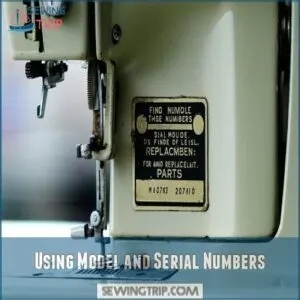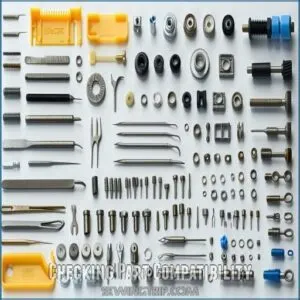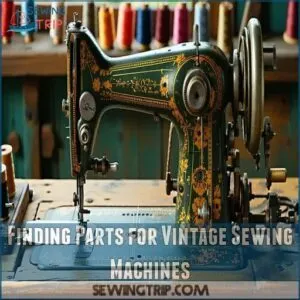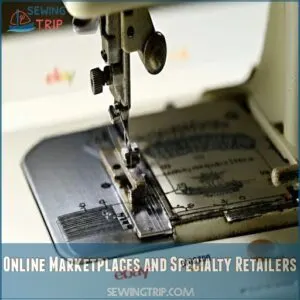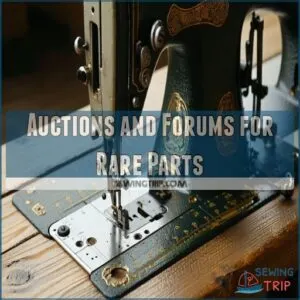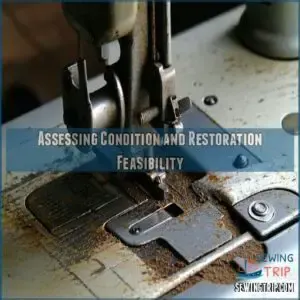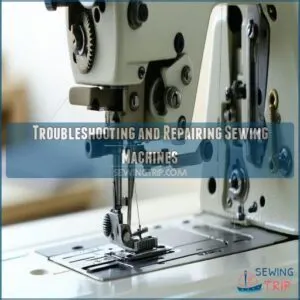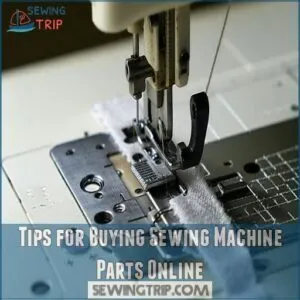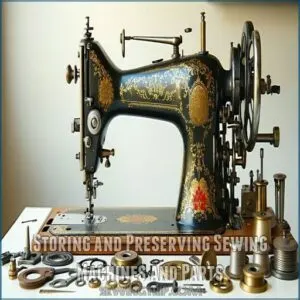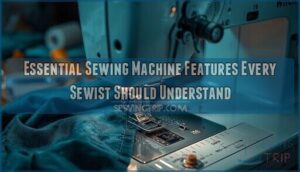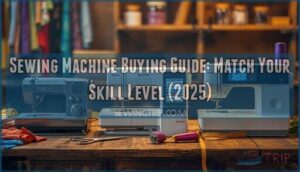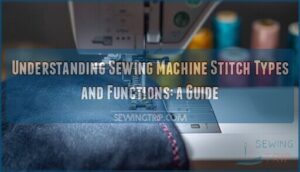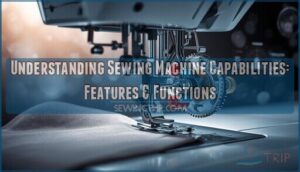This site is supported by our readers. We may earn a commission, at no cost to you, if you purchase through links.
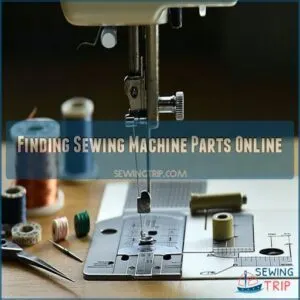 Finding sewing machine parts online is easier than you think! Start by identifying your machine’s model and serial number—they’re your golden ticket to the right replacement parts.
Finding sewing machine parts online is easier than you think! Start by identifying your machine’s model and serial number—they’re your golden ticket to the right replacement parts.
Websites like GoldStar Tool and specialized online retailers offer a treasure trove of options for brands like Singer, Brother, and Janome.
Compare prices, read seller reviews, and check shipping fees to snag the best deal. Pro tip: universal parts can save you time and money.
Whether you’re fixing a vintage gem or a modern marvel, the internet’s got your back. Just be sure to verify part authenticity and compatibility before clicking "buy."
Want to become a sewing machine repair pro?
Table Of Contents
- Key Takeaways
- Finding Sewing Machine Parts Online
- Identifying Correct Sewing Machine Parts
- Sourcing Parts for Specific Sewing Machine Brands
- Finding Replacement Parts for Vintage Sewing Machines
- Troubleshooting and Repairing Sewing Machines
- Tips for Buying Sewing Machine Parts Online
- Storing and Preserving Sewing Machines and Parts
- Frequently Asked Questions (FAQs)
- Conclusion
Key Takeaways
- You’ll find the best parts by identifying your sewing machine’s exact model and serial number, which is crucial for ensuring compatibility with replacement components.
- Online retailers like GoldStar Tool and specialized marketplaces offer extensive selections of parts for various brands, allowing you to compare prices, read reviews, and find both original and universal parts.
- Vintage sewing machine enthusiasts can leverage online forums, auction sites, and specialty retailers to source rare parts, but you’ll need to carefully assess the condition and restoration feasibility before investing.
- You’ll save money and time by checking part authenticity, understanding your machine’s specific requirements, and comparing shipping costs across different online platforms before making a purchase.
Finding Sewing Machine Parts Online

You’re in luck if you’ve got a sewing machine that needs repairs or replacement parts!
Online retailers like GoldStar Tool and specialty shops offer a treasure trove of parts for everything from vintage Singer machines to the latest computerized models.
Making it easier than ever to get your beloved sewing companion back in stitching condition.
Top Online Retailers for Sewing Machine Parts
Need replacement parts without breaking the bank?
Top online sewing machine parts retailers like GoldStar Tool make finding what you need a breeze.
Check their retailer reviews, compare shipping costs, and explore extensive part selections.
You can also find a wide variety of sewing machine parts to suit your needs.
With worldwide shipping, in-house manufacturing, and killer customer service, you’ll get the right part without the headache – all at prices that won’t sew holes in your wallet.
Benefits of Buying Sewing Machine Parts Online
The virtual world of sewing machine parts shopping opens up a treasure trove of convenience for crafty creators.
You’ll gain cost savings, wide selection, and fast shipping at your fingertips when buying sewing machine parts online.
When replacing parts for industrial sewing machines, consider factors such as servo or clutch motors.
With 24/7 access to top sewing machine parts suppliers, you can compare prices, read reviews, and get expert advice without leaving your workspace.
Identifying Correct Sewing Machine Parts
When hunting for the right sewing machine parts, your model and serial number are your best detective tools.
You’ll want to grab these key identifiers before starting your online parts quest, ensuring you find the perfect match for your beloved machine.
Using Model and Serial Numbers
How can you decipher the mystery of your sewing machine’s identity? Mastering part identification is your ticket to successful repairs.
Since many sewing machine parts, such as those for vintage Kenmore models, are largely universal across models, increasing accessibility check Kenmore sewing machine parts.
Here’s your roadmap to cracking the code:
- Examine the machine’s body for hidden serial number clues
- Snap a clear photo of the number
- Check manufacturer-specific locations
- Research online forums and reference guides
- Consult specialty sewing machine parts retailers
Your machine’s unique code is the key to finding exactly what you need.
Checking Part Compatibility
Someone might struggle with sewing machine part compatibility, but don’t sweat it. Matching parts requires careful cross-referencing and attention to detail. Check your machine’s exact model number and compare specifications before purchasing.
| Compatibility Factor | What to Check | Potential Issues |
|---|---|---|
| Part Numbers | Exact match | Misfit replacements |
| Machine Model | Precise series | Incorrect sizing |
| Manufacturing Year | Production details | Outdated components |
| Mechanical Specifications | Technical requirements | Performance failures |
Consulting online guides and expert advice can save you headaches and costly mistakes.
Finding Parts for Vintage Sewing Machines
Hunting down vintage sewing machine parts requires sharp detective skills.
Want to rescue that old beauty? Your quest starts with pinpointing its exact model and serial number.
Familiarizing yourself with modern sewing machine features like automatic needle threader can also help when sourcing rare parts.
Consider these key strategies for sourcing rare parts:
- Check online specialty retailers
- Explore vintage sewing forums
- Scour auction sites
- Connect with restoration communities
Master part identification and you’ll breathe new life into cherished machines.
Sourcing Parts for Specific Sewing Machine Brands
If you’re hunting for sewing machine parts, you’ll need to know the exact brand and model to guarantee a perfect match.
Whether you’re fixing a vintage Singer or a modern Brother machine, finding the right replacement parts online can save you time, money, and frustration.
Singer Sewing Machine Parts and Repair
With over 2,000 Singer sewing machine models in circulation, you’ll need a game plan for finding the right parts.
Online retailers like those offering Singer sewing machine parts can be a great resource for hard-to-find components.
| Part Type | Key Considerations |
|---|---|
| Needles | Match fabric and project type |
| Presser Feet | Vary by stitch and material |
| Body Components | Include spool caps, pins, sponges |
| Gears | Require precise fitting |
Master your machine’s quirks, and you’ll keep stitching like a pro.
Brother Sewing Machine Parts and Accessories
Craving the perfect Brother sewing machine part? You’re in luck! These machines are a dream for crafty DIY enthusiasts seeking reliable replacements.
Here’s your game plan for scoring those coveted accessories:
- Know your exact Brother part numbers
- Check manufacturer warranty coverage
- Compare prices across multiple online retailers
- Verify part compatibility before purchasing
- Consider genuine vs. aftermarket replacement options
Finding the right part doesn’t have to be a headache.
Finding Parts for JUKI, Janome, and Pfaff Machines
After exploring Brother’s parts landscape, sewing enthusiasts can easily shift gears to JUKI, Janome, and Pfaff machines.
Online retailers like GoldStar Tool offer extensive selections for these brands.
Check model numbers carefully, read retailer reviews, and compare prices.
Whether hunting a rare Pfaff part or a standard Janome component, patient searching pays off in finding the perfect sewing machine repair solution.
When troubleshooting issues like reverse stitching, make certain proper feed dog maintenance to prevent costly repairs.
Finding Replacement Parts for Vintage Sewing Machines
If you’ve got a cherished vintage sewing machine gathering dust, don’t give up hope on finding the right replacement parts.
With a mix of online marketplaces, specialty retailers, and collector forums, you’ll be surprised at how many rare components are just a click away.
Online Marketplaces and Specialty Retailers
Ready to hunt down those elusive sewing machine parts?
Online marketplaces like eBay and Amazon are your treasure map.
Check retailer reviews religiously, peek at shipping costs, and inspect return policies like a detective.
Specialty sites offer authentic parts that’ll breathe new life into your machine.
Pro tip: Always read the fine print before hitting "buy" to avoid unexpected surprises.
Auctions and Forums for Rare Parts
The scarcity of vintage sewing machine parts transforms online auctions and forums into treasure troves for dedicated enthusiasts. Hunting rare components requires strategic navigation: dedicated collectors also find specialty websites like those offering vintage sewing parts that are invaluable resources.
- Join specialized sewing machine forums to connect with experienced collectors
- Check reputable auction sites like eBay for authentic parts
- Build relationships with seller communities to uncover hidden part gems
Learn forum etiquette, research part values, and master smart bidding strategies.
Assessing Condition and Restoration Feasibility
Once you’ve scored those rare sewing machine parts, inspect your vintage find like a detective.
Weigh the restoration cost against its potential value, keeping in mind the key role of balanced thread tension.
Check for missing components, rust damage, and mechanical wear.
Some machines are gems waiting to shine, while others might be better left on the shelf.
Your project’s success hinges on careful assessment and realistic expectations.
Troubleshooting and Repairing Sewing Machines
When your sewing machine starts acting up, don’t panic—most issues are simple fixes.
you can handle with the right knowledge and tools.
Learn how to troubleshoot common problems, identify the parts you’ll need, and get your trusted machine back to stitching smoothly in no time.
Common Issues With Vintage Sewing Machines
After hunting down rare vintage sewing machine parts, you’ll want to tackle those pesky mechanical gremlins head-on. Vintage machines pack personality but come with quirks that’ll test your patience.
For instance, a buildup of lint, hardened oil, and thread residue in the shuttle mechanism can cause erratic tension issues, often requiring a deep cleaning routine.
Check out these common culprits:
- Needle alignment throwing stitches off-kilter
- Bobbin jams hijacking your creative flow
- Tension problems turning smooth fabric into a nightmare
- Tension problems turning smooth fabric into a nightmare
Buckle up for a repair adventure that separates true craftspeople from casual hobbyists.
Basic Tools for Repair and Maintenance
When those vintage sewing machines start acting up, your repair arsenal matters.
Grab an essential tool kit packed with precision screwdrivers, needle-nose pliers, fine tweezers, and a soft-bristled brush.
Lubrication methods require special lightweight machine oil and clean rags.
Throwing in a magnifying glass helps spot tiny part details.
Safety glasses protect your eyes while tinkering with delicate sewing machine parts.
Regular thread tension adjustments can also prevent common stitching issues.
Sourcing Replacement Parts Locally or Online
Got a broken sewing machine? Three key strategies can help you score the right replacement parts.
Hit up local sew shops for hands-on advice and immediate solutions.
Online sewing machine parts stores like GoldStar Tool offer wider selections and competitive prices. Compare shipping options, read customer reviews, and check warranties to make certain you’re getting quality parts that’ll breathe new life into your beloved machine.
Tips for Buying Sewing Machine Parts Online
When you’re hunting for sewing machine parts online, knowledge is your best tool for success.
You’ll want to compare prices.
verify part authenticity, and check shipping fees.
to guarantee you’re getting the right component at the best value.
Comparing Prices and Shipping Fees
Hunting for the best deal on sewing machine parts? Smart shoppers leverage price comparison websites to save big.
- Check multiple online sewing machine parts stores
- Factor in shipping costs from different vendors
- Look for bulk discounts and seasonal promotions
Snag those cheap sewing machine parts without breaking the bank by comparing prices across eBay, specialty retailers, and online marketplaces.
Ensuring Part Authenticity and Quality
Because spotting authentic sewing machine parts can be tricky, you’ll want to become a savvy shopper. Check seller reviews, warranty details, and part markings carefully to dodge counterfeits.
Ensuring your sewing machine has features such as automatic needle threader can also help streamline your sewing process and make maintenance easier.
Here’s a quick guide to help you distinguish genuine from fake:
| Authentic sewing machine parts | Red Flags |
|---|---|
| Clear markings | Blurry or missing markings |
| Manufacturer warranty | No return policy or warranty |
| Detailed product specs | Suspiciously low prices or incomplete specs |
| Verified seller history | Anonymous sellers or poor reviews |
| Matching serial numbers | Inconsistent part details |
Storing and Preserving Sewing Machines and Parts
Protect your sewing machine’s longevity by storing it in a dry, temperature-stable environment with a breathable cover to prevent dust and rust.
Handle your machine with care, regularly oil its moving parts, and inspect power cords.
Guarantee your treasured crafting companion stays in prime condition for years to come.
Proper Storage and Maintenance Techniques
After scoring great deals on parts, protect your sewing machine investment with smart storage techniques.
Your machine needs TLC to keep running smoothly and looking sharp. Think of maintenance like giving your trusted crafting companion a five-star treatment.
- Create a dedicated clean storage space
- Use breathable cotton dust covers
- Apply thin layer of specialized sewing machine oil
- Keep machine away from direct sunlight
- Store in temperature-controlled environment
Treat your machine right, and it’ll be your creative partner for years to come.
Preventing Rust and Damage to Parts
Shielding your sewing machine parts from rust is like giving your trusty sidekick a protective armor.
Moisture’s your enemy, so keep parts dry with silica gel packets and climate-controlled storage.
Apply a thin layer of protective oil to metal surfaces, wipe down after use, and store in a clean, dust-free environment to prevent corrosion and wear.
Handling and Care for Vintage Sewing Machines
Your vintage sewing machine deserves some TLC to keep it humming smoothly through decades of crafting. Think of it like a classic car – it needs gentle, consistent care to preserve its magic. Additionally, learning about the aesthetic and functional advantages of vintage sewing machines vintage sewing machine benefits can help you better understand the importance of proper care.
- Handle the machine with clean, dry hands to prevent oil and dirt transfer
- Always lift from the bottom, supporting its full weight carefully
- Store in a protective case or dust cover when not in use
Frequently Asked Questions (FAQs)
Where can I find sewing machine replacement parts?
Check online retailers like GoldStar Tool, which offers worldwide shipping and parts for Singer, Brother, and other brands.
Explore specialty shops, forums, and marketplaces to find the exact replacement part you need.
How do I know what parts fit on my sewing machine?
Identify your machine’s make and model number. Call manufacturers or specialized retailers like GoldStar Tool with these details. They’ll pinpoint exact compatible parts, saving you time and potential costly mistakes.
What specific sewing machine part do I need?
Stuck with a sewing machine mystery?
Decoding the right part feels like cracking a code.
Grab your machine’s model number, snap a clear photo, and hunt down compatibility with a seasoned parts expert.
Why should I buy sewing machine parts online?
You’ll save money, find rare parts quickly, and get expert guidance online. With worldwide shipping, competitive prices, and hassle-free returns, buying sewing machine parts online beats hunting locally every time.
Can I repair my Brother Sewing Machine?
With the right parts and some DIY skills, you can definitely repair your Brother Sewing Machine.
Check online retailers like GoldStar Tool.
Watch tutorial videos, and don’t hesitate to seek expert advice if you’re unsure.
How do replacement sewing machine parts impact warranty?
Worried about voiding your warranty?
Aftermarket parts can be tricky.
Manufacturers typically require original parts for warranty coverage.
Check your manual carefully before replacing components to verify you don’t unintentionally invalidate your sewing machine’s protection.
Can 3D printing help manufacture sewing machine parts?
3D printing offers a promising solution for manufacturing sewing machine parts, letting you recreate rare or discontinued components.
However, precision and material compatibility remain critical challenges for DIY enthusiasts seeking custom replacements.
How environmentally friendly are sewing machine replacement parts?
Eco-conscious sewers can breathe easier! Many manufacturers now prioritize sustainability. Brother’s recycling programs and targeted environmental efforts mean you’re supporting greener practices when replacing your machine’s parts.
Are international shipping costs for parts reasonable?
You’ll want to compare shipping rates across retailers.
GoldStar Tool offers worldwide shipping.
GoldStar Tool offers a flat $99 fee in the U.S.
International costs vary, so check their website for the most current pricing details.
Conclusion
Imagine your sewing machine as a trusted companion waiting to be revived.
Whether you’re hunting for finding sewing machine parts online or restoring a vintage treasure, you’ve got the tools to succeed.
With the right research, patience, and online resources, you’ll breathe new life into your machine.
Don’t let a broken part stop your creative journey—embrace the repair process, compare options, and keep your passion for sewing alive.

